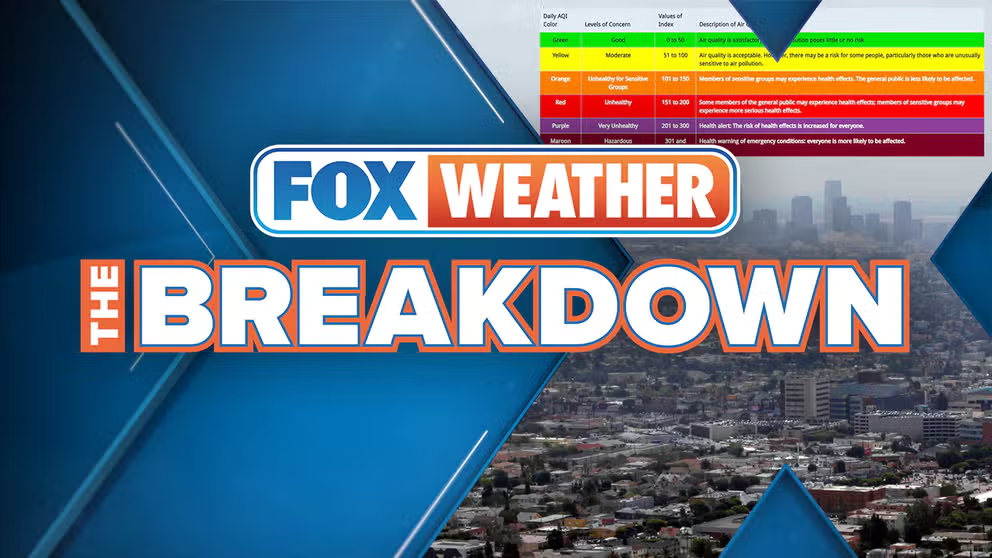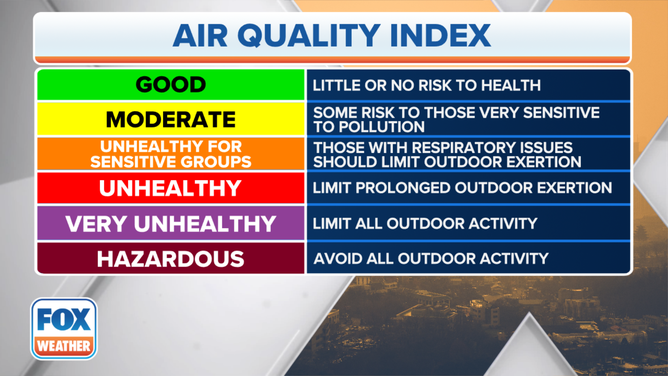US Air Quality Map
Welcome to FOX Weather's U.S. Air Quality Map. This map allows you to track the air quality index (AQI) across the United States in real-time. Our interactive map displays the current AQI for each state, with color-coded markers indicating whether the air quality is good, moderate, unhealthy for sensitive groups, unhealthy, very unhealthy, or hazardous.
How is air quality measured?
Learn how air quality is measured.
FOX Weather’s U.S. Air Quality Map is an important resource for checking air quality levels in your area or where you plan to travel.
Checking air quality can help you decide what action to take to lessen the impacts of air pollution that can significantly impact your health.
What are the current air quality levels near me?
Are you wondering what the current air quality levels are in your area? Perhaps you have loved ones who are being urged to take precautions during an air quality action day.
This map shows the six levels of the Air Quality Index (AQI) from "Good" to "Hazardous" across the continental U.S.
WHICH CITIES HAVE THE WORST AIR POLLUTION IN AMERICA?

(FOX Weather)
What is an Air Quality Alert and where are Air Quality Alerts in effect near me?
An Air Quality Alert is issued when pollution in the air is expected to reach unhealthy levels. There are numerous air pollution control agencies across America, each having slightly different terminology for such days and using varying AQI levels when considering them.
According to AirNow.gov, air quality action days are most commonly put into effect when the AQI is expected to be unhealthy or Code Red (AQI value of 151 to 200). In this case, everyone should reduce exposure to air pollution, especially the members of the sensitive groups for that day’s particular pollutant.

(FOX Weather)
What is the Air Quality Index (AQI)?
A regular assessment of air quality in the U.S. began in 1976, about six years after the creation of the Environmental Protection Agency.
The Air Quality Index, better known as AQI, was released in 1999, according to AirNow.gov. The AQI has undergone several updates over the years, but the goal has been the same – to offer people an easy-to-understand daily report about the air they're breathing and to show what air quality is dangerous.
The air quality report provides an air quality number for five major pollutants:
- Ground-level ozone
- Particle pollution (also known as particulate matter)
- Carbon monoxide
- Sulfur dioxide
- Nitrogen dioxide
Each of the Air Quality Index categories corresponds to a different set of health concerns that people should consider when being outside for extended periods of time.
Here’s a closer look at each category and how you should react to each of them.
Green, with an air quality index value between 0-50, means that the air quality is good and pollution poses few health risks.
Yellow, with an air quality index value between 51-100, means that air quality is moderate. While the air quality is satisfactory, it may pose a risk to people who are unusually sensitive to pollution, and those people should consider reducing time spent outdoors.
Orange, with an air quality index value between 101-150, means the air quality is unhealthy for sensitive groups. The public is less likely to experience adverse effects, but people sensitive to air pollution may experience problems. Sensitive groups should reduce their time outdoors. People with asthma should keep quick-relief medicine handy, and those suffering from heart disease should immediately contact their healthcare provider if they experience palpitations, fatigue or shortness of breath.
Red, with an air quality index value between 151-200, means the air is unhealthy. The public may experience health problems, and people sensitive to air pollution may experience more severe effects. Sensitive groups should avoid prolonged periods outside, while others should reduce their time outdoors.
Purple, with an air quality index value between 201-300, means the air is very unhealthy. Officials will usually issue health alerts at this level because the risk of health problems from air pollution is increased for everyone. Sensitive groups should avoid all outdoor activities, while everyone else should avoid prolonged time outside.
Maroon, with an air quality index value between 301-500, is the worst level on the AQI and means the air is considered hazardous. Officials will usually describe this as a health emergency because just about everyone will experience problems from air pollution. Everyone should avoid all physical activity outside. Sensitive groups should remain indoors and keep their activity levels low.


